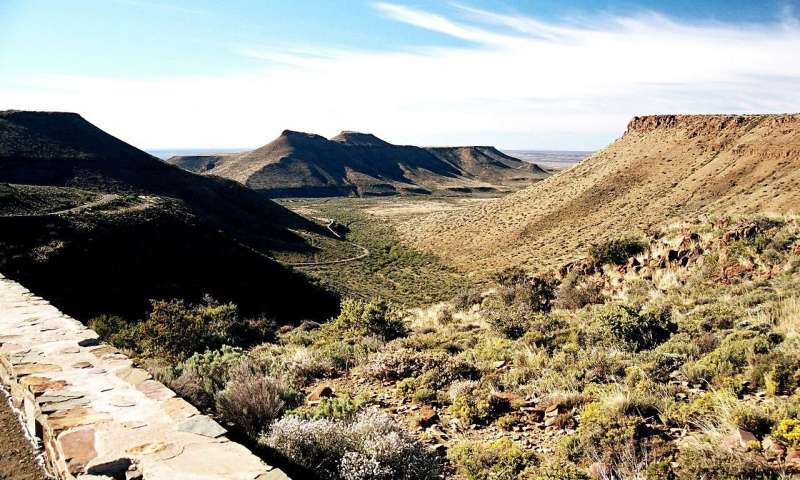William sent a link to this story but see https://phys.org/news/2019-12-mass-extinction-sea-biodiversity-million.html … the End of Permian mass extinction event 250 million years ago has had reams of material published – including many books. It is one of those settled subjects. Perhaps it was not all it was cracked up to be. Geologist Robert Gastaldo is said to have recorded the most definitive proof to date that the extinctions did not occur at the same time. These findings have implications for the impact of a comparable future diversity crisis caused by climate change and a warming planet. The latter sentence is an odd attachment to what should have been a geological essay – and one that would make a lot of people suspicious.
The findings come from 15 years of painstaking research in South Africa's Karoo Basin (see image below) – but notice the escarpments … … The research is said to show an 'event' devastated marine life but did not affect life on the land. Terrestrial change happened hundreds of thousands of years earlier – and very gradually. This of course sums up the problems caused by a uniformitarian or gradualist view of the record of the rocks. Sedimentary layers during a devastating catastrophe would have been laid down quickly – not over hundreds of thousands of years. We regularly have similar geological research papers surrounding the K/T event – all down to uniformitarian timescales. Now, if that escarpment on the R/H side of the image above, had been laid down uniformly and quickly (a deep layer of sediments) one might put it all down to the same event that caused the mass extinction of marine life. Trying to unravel the catastrophism from the normal course of events, in geological terms, will take a long time – if it ever begins.
… The research is said to show an 'event' devastated marine life but did not affect life on the land. Terrestrial change happened hundreds of thousands of years earlier – and very gradually. This of course sums up the problems caused by a uniformitarian or gradualist view of the record of the rocks. Sedimentary layers during a devastating catastrophe would have been laid down quickly – not over hundreds of thousands of years. We regularly have similar geological research papers surrounding the K/T event – all down to uniformitarian timescales. Now, if that escarpment on the R/H side of the image above, had been laid down uniformly and quickly (a deep layer of sediments) one might put it all down to the same event that caused the mass extinction of marine life. Trying to unravel the catastrophism from the normal course of events, in geological terms, will take a long time – if it ever begins.
At https://phys.org/news/2019-12-australia.html … new research has revealed flowering plants go back 126 million years ago and they may have resembled modern magnolias, buttercups and laurels. The flowers of some modern laurels are sweet and fragrant – but short lived. So too are magnolias – a burst of glorious flower in the spring (and then a drab rest of year). Apparently, flowering plants did not reach the southern stretches of Australia, possible more strictly the SE, as it was too cold – or that is the theory. Australia during the dinosaur age may have been closer to the South Pole – still attached to what is now Antarctica. However, as dinosaurs also graced the extremities of Antarctica we may wonder.
